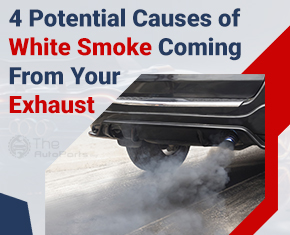As drivers, we have a tendency to know our cars rather well. Because of this, the majority of drivers can spot little variations in how their car behaves from day to day. We are frequently eager to identify any problems that appear because we consider their symptoms to be “new” or “weird.”
This frequently happens when a person observes smoke of any kind coming from the exhaust of their car. Many people find this to be a significant reason for concern since it forces them to think about the possible causes of the abrupt shift in their exhaust’s appearance.
One of the most frequent issues with this kind of exhaust is what seems to be white exhaust smoke. Any passerby in the vicinity may immediately see this form of smoke because it is frequently fairly dense in nature. There is good reason to be concerned because this smoke frequently manifests itself most visibly at starting or acceleration.
Continue reading to find out the possible reasons for white exhaust smoke and how to deal with them if they recur in the future.
Exhaust Emissions: How Should They Appear?
Any time an engine is operating, the exhaust from a vehicle should, in a perfect world, be rather clean. This is a sign of good combustion efficiency, which results from generally satisfactory engine health.
Simply explained, an engine involves introducing air and fuel into each cylinder at the right rate. Then, this mixture of fuel and air is burned thoroughly, releasing little in the way of dangerous hydrocarbons, oxides, and dioxides.
In turn, a car’s exhaust should be hard, if at all, discernible.
A lack of exhaust smoke in general suggests that nothing that should not be entering a vehicle’s combustion chambers is doing so under ideal conditions. This mostly refers to coolant and oil, neither of which should be present in any appreciable quantity during combustion.
However, it is important to note that it is totally typical for a vehicle’s exhaust to emit sporadic quantities of light grey or white smoke immediately after ignition or when the surrounding environment is unusually chilly.
This happens when minute quantities of water heat up inside a car’s exhaust. Condensation, a natural process, is what led to the presence of this water.
However, these minute quantities of water should be dissipated quite rapidly and result in smoke that is light in color and not unduly thick. This kind of exhaust smoke, or rather steam, should leave a vehicle’s exhaust system quickly after being released.
If the exhaust smoke does not go soon or seems to become thicker over time, there may be another underlying problem. In this instance, more diagnostic will be necessary to identify the current problem.
Reasons Your Exhaust Is Blowing White Smoke
The reason for such problems can occasionally vary, even though the presence of white-colored exhaust smoke is virtually always symptomatic of water/coolant contamination within one or more cylinders.
The most frequent reasons for white exhaust smoke are the following:
1. A ruptured head gasket
A ruptured head gasket is frequently to blame when a car’s exhaust emits thick, white smoke. This vital gasket ensures a tight seal between the engine block and cylinder heads and guards against coolant, oil, and compression leaks.
Coolant can leak into one or more engine cylinders when a head gasket fails, where it is burned and produces white smoke as a byproduct.
2. Compromised Intake Manifold Gasket
It’s possible for an intake manifold gasket leak to cause thick, white exhaust smoke in some circumstances. Of course, this is only accurate if the water jackets in your engine’s intake manifold are used. In these conditions, a blown intake gasket can cause coolant to enter one or more engine cylinders, causing many of the same symptoms as a blown head gasket.
3. Cracked/Warped Cylinder Head
Thick, white exhaust smoke may potentially be the result of a damaged cylinder head.
A broken cylinder head can let coolant leak into one or more combustion chambers, where it is subsequently burned, producing white smoke as a result, similar to what happens in the event of a blown head gasket. The damaged cylinder head must be replaced in order to solve this issue.
4. Cracked Engine Block
Despite being less frequent, an engine’s block might break, enabling coolant to enter one or more cylinders. Unfortunately, this kind of failure is regarded as catastrophic in nature, and it usually means the engine in question is finished.
At this stage, a driver must decide if it is cost- and downtime-effective to replace the engine on their car.
Is Driving Safely Continued?
While it may not always be particularly dangerous to drive a car that has white exhaust smoke coming out of it, it is never a good idea. As previously indicated, the presence of thick, white smoke coming from a car’s exhaust suggests that coolant is being burned, at least to some extent. This not only increases the chance of overheating but also creates additional issues.
There is a possibility of hydro lock if coolant has entered one or more combustion chambers.
The situation known as “hydro lock” occurs when non-compressible water accumulates inside the combustion chamber and prevents a piston from moving upward within its appropriate cylinder bore. This problem frequently causes serious, irreparable engine damage.
In any case, the underlying issue that is causing the white exhaust smoke should be identified and fixed as quickly as it is feasible. In addition to reducing the possibility of more engine damage, doing this will stop the problem from getting worse.
If you are not confident doing such repairs yourself, schedule an appointment with a reputable automotive service facility as soon as possible.
